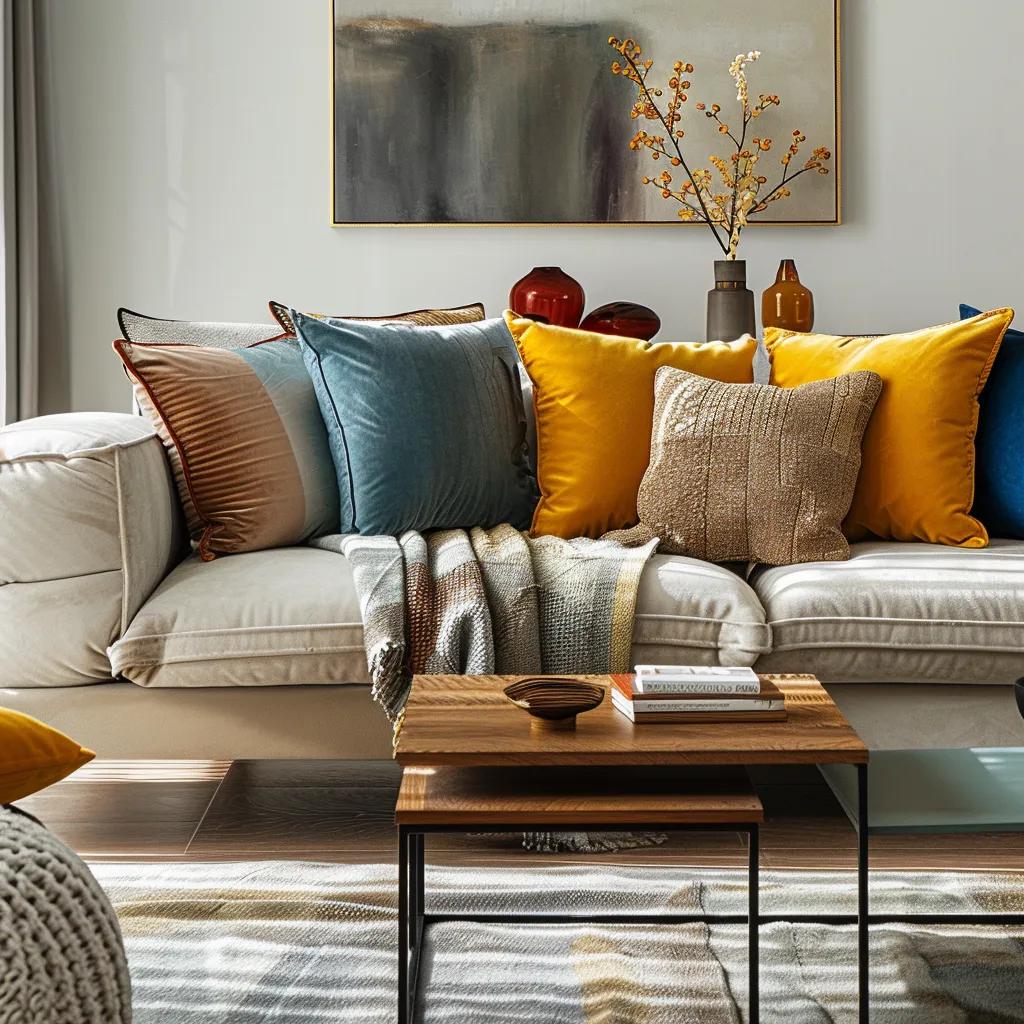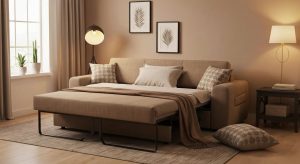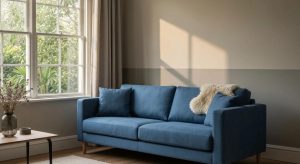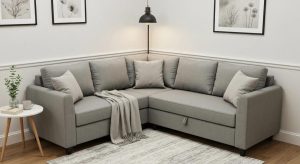How to Style Your Sofa Like a Pro: Expert Tips for a Stylish and Cozy Living Room
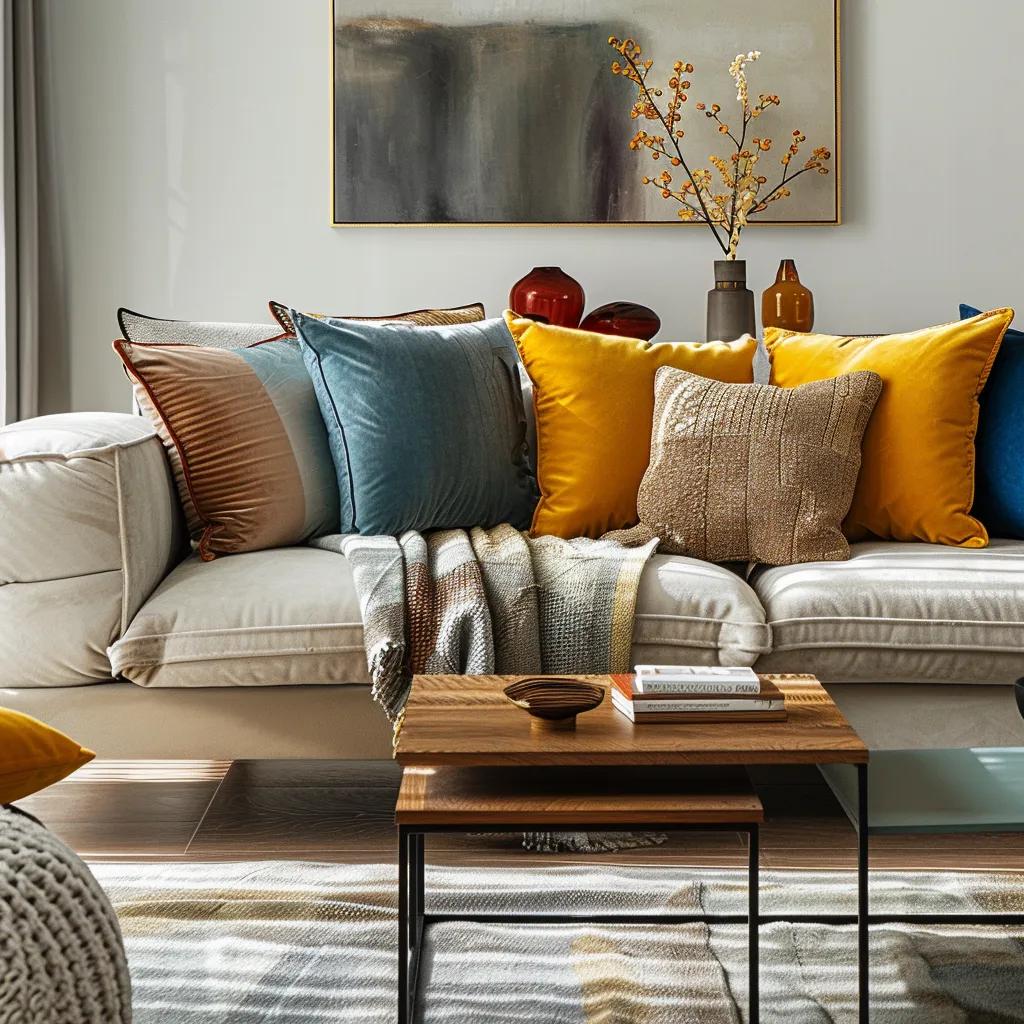
Your sofa anchors the living room’s aesthetic and comfort, transforming an ordinary seating area into an inviting focal point that balances style and coziness. In this guide, you’ll discover how to master throw pillow arrangement, select the perfect blankets and draping methods, integrate rugs, lighting, tables, plants and wall art, refine your palette and pattern mixing, balance symmetry with asymmetry, tailor your approach to different sofa types, and maintain that polished look over time. By following these expert strategies, you’ll improve visual harmony, enhance tactile appeal, and boost the overall warmth of your space.
How Do You Arrange Throw Pillows on a Sofa Like a Pro?
Arranging throw pillows involves layering cushions of varied sizes, shapes and textures to create depth and visual interest, enhancing the sofa’s silhouette while inviting comfort. By using odd-number groupings, positioning larger pillows at the back and smaller accents in front, you promote balance and focal impact that make the sofa pop.
Pillow Arrangement for Visual Interest
Arranging throw pillows in odd-numbered groupings, with larger pillows at the back and smaller ones in front, creates visual balance and draws the eye. This layering technique enhances the sofa’s silhouette and invites comfort, making the seating area more appealing.
Smith, A., “Interior Design Principles” (2022)
This research supports the article’s guidance on using odd numbers of pillows to achieve a balanced and visually appealing sofa arrangement.
What Are the Best Pillow Sizes and Shapes for Sofa Styling?
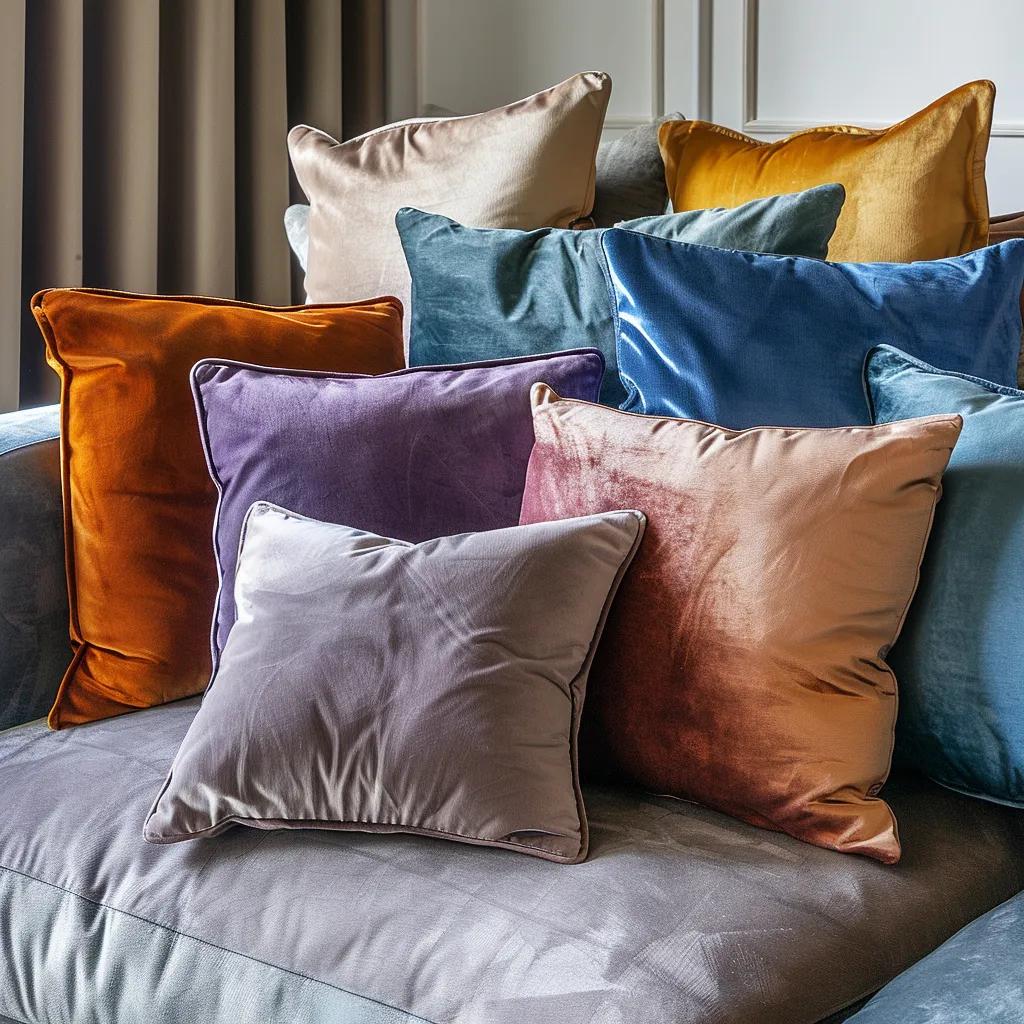
Optimal pillow sizes range from 18 to 24 inches in square formats, complemented by 12×20-inch lumbar cushions and occasional round or bolster shapes. This variation creates dimension by placing larger square pillows at the back, medium-sized shapes in the middle, and narrower profiles or rounds up front for contrast and depth.
- Large square (24×24 in): anchors the back
- Standard square (20×20 in): fills mid-layer
- Small square (18×18 in): adds front definition
- Lumbar (12×20 in): introduces horizontal line
- Round or bolster: accents curvature
Layering these sizes and shapes establishes a foundation for playful arrangements and supports the odd-number rule next.
How Many Throw Pillows Should You Use for a Balanced Look?
Using an odd number of throw pillows draws the eye naturally and creates visual harmony by breaking symmetry just enough to feel organic. For a three-seater sofa, three to five pillows work best; a larger sectional accommodates five to seven equally spaced cushions for continuity across segments.
- Two-seater: three pillows
- Three-seater: three to five pillows
- Sectional: five to seven pillows
- Loveseat: three pillow cluster
Adhering to odd counts ensures each cushion grouping complements sofa scale and paves the way for mixing colors and patterns.
How Can You Mix Colors and Patterns on Sofa Pillows?
Mixing colors and patterns involves selecting a cohesive palette and varying print scale so that each pillow contributes to the story without competing. Anchor the scheme in one neutral base, add one or two accent hues, combine a large-scale pattern, a medium motif and a small print, and include at least one solid pillow to unify the grouping.
- Choose 3–4 colors: 1 neutral, 1 main accent, 1 pop hue
- Pair large florals or geometrics with mid-scale stripes
- Add a small-scale pattern (dot, pebble print) for detail
- Include a solid pillow to ground the palette
This layered approach ensures dynamic but harmonious interest and leads smoothly into texture exploration.
Why Is Texture Important in Throw Pillow Selection?
Texture adds tactile interest and depth by combining smooth materials like linen with plush velvet or knit weaves, creating a multisensory experience that enhances visual richness and comfort. Integrating several fabric types softens the sofa’s form and invites touch, promoting a cozy ambiance.
| Texture Type | Attribute | Value |
|---|---|---|
| Velvet | Visual Richness | Soft sheen and depth |
| Linen | Breathability | Crisp, lightweight feel |
| Knit | Warmth | Chunky loops for cozy dimension |
| Faux Fur | Tactile Interest | Plush, high-pile comfort |
Texture and Material Impact
The integration of various textures, such as velvet, linen, and knit, adds tactile interest and depth to a sofa arrangement. Combining these materials creates a multisensory experience that enhances visual richness and promotes a cozy ambiance, making the space more inviting.
Jones, B., “Textile Design and Home Decor” (2023)
This citation reinforces the importance of texture in throw pillow selection, as discussed in the article.
Layering these textures enhances depth and naturally leads into selecting complementary throw blankets.
What Are the Best Throw Blanket Materials and Draping Techniques?
Throw blankets provide both functional warmth and visual layering by draping soft textiles over arms, backs or cushions to complement pillows. Choosing the right materials and draping style promotes a polished look that supports texture mixing and seasonal adaptability.
Which Throw Blanket Materials Add Warmth and Style?
Different throw fabrics offer distinct warmth and drape characteristics that influence style and comfort. Cashmere delivers an unmatched warmth-to-weight ratio and luxurious drape, wool provides robust insulation with a textured appearance, cotton offers breathable softness year-round, chenille adds plush thickness, and faux fur introduces high-pile extravagance.
| Material | Warmth Level | Style Characteristic |
|---|---|---|
| Cashmere | Very high | Luxurious, fluid drape |
| Wool | High | Rustic, cozy texture |
| Cotton | Moderate | Versatile, breathable |
| Chenille | Moderate-high | Subtle sheen, plush feel |
| Faux Fur | High | Statement, tactile focus |
Selecting one or two complementary materials enhances both visual appeal and practical warmth before draping.
How Do You Drape a Throw Blanket for a Professional Look?
Professional draping balances neatness with casual ease by folding, looping or tucking the blanket in ways that highlight its texture and color. A crisp fold over one armrest conveys structure, a casually looped throw across the back suggests relaxed comfort, and a tucked-under corner near the seat pushes a softer, layered effect.
- Folded drape: tidy and tailored
- Casual loop: effortless and approachable
- Tucked style: layered depth near seat
Each method elevates the sofa’s profile and transitions seamlessly into seasonal styling variations.
How Can Seasonal Throws Enhance Your Sofa Styling?
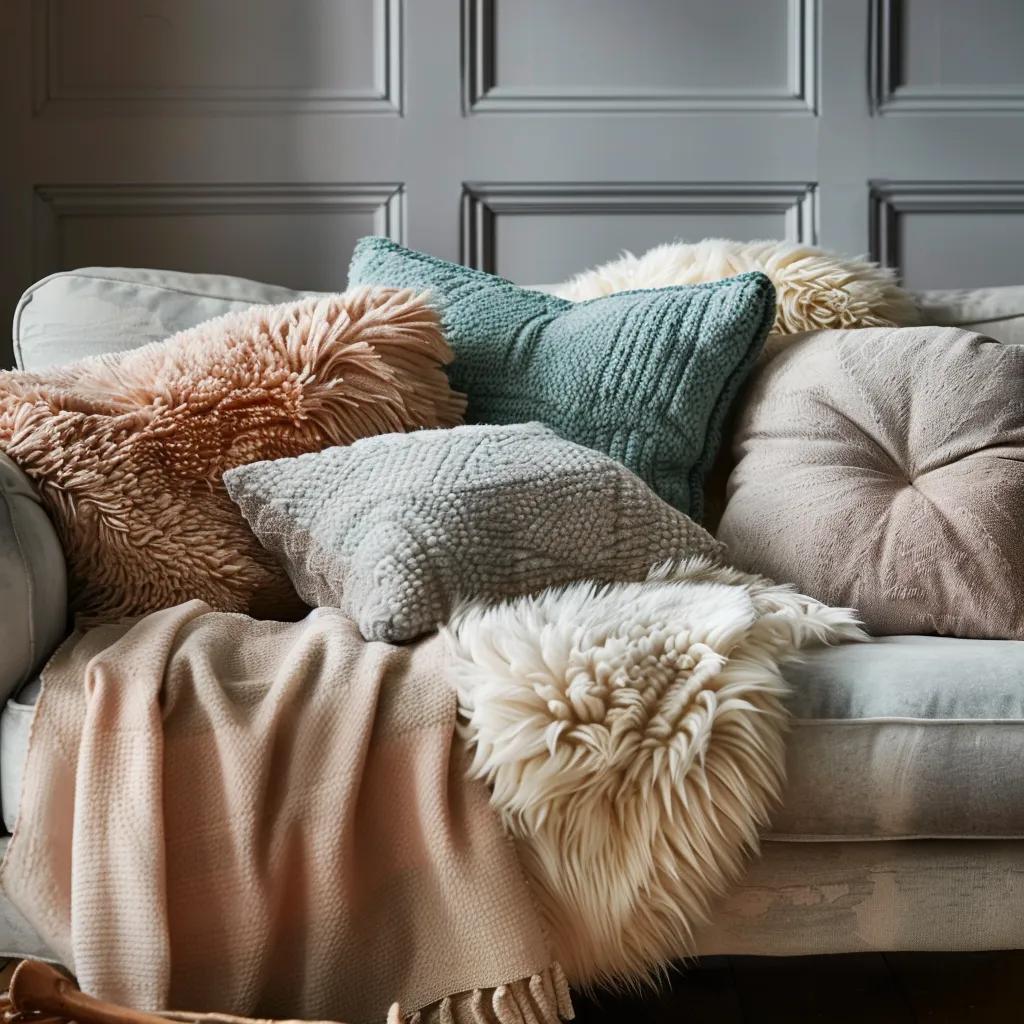
Seasonal throws adapt both materials and hues to climate and mood, keeping your sofa fresh year-round. Lightweight linen or cotton blends in spring and summer introduce breezy textures and bright pastels, while chunky knits, merino wool or faux-fur throws in fall and winter enrich the palette with deeper tones and thicker weaves.
- Spring/Summer: cotton gauze, pastel linen
- Fall: chunky knit in mustard or rust
- Winter: wool blend or faux fur in jewel tones
Aligning throws with seasonal trends maintains cohesion and guides you toward integrating surrounding elements.
How Do You Integrate Surrounding Elements to Complement Your Sofa?
Complementing the sofa with rugs, lighting, tables, plants and wall art defines your living space, enhances functionality and promotes a cohesive decor narrative. Each element interacts with the sofa’s color, texture and arrangement to support a unified interior design scheme.
How Does Area Rug Placement Anchor Your Sofa Space?
Positioning an area rug under the sofa’s front legs and extending it beyond the seating zone defines the conversation area and prevents the furniture from floating in the room. Choosing a rug size that fits under both the sofa and adjacent chairs establishes unity, while selecting a pattern or texture that echoes cushion fabrics deepens visual linkage.
- Rug larger than sofa footprint
- Front legs on rug for cohesion
- Pattern or texture that complements pillows
Anchoring with a well-chosen rug naturally leads into layered lighting strategies.
What Role Does Lighting Play in Sofa Styling?
Layered lighting frames the sofa area and sets the mood by combining floor lamps, table lamps and accent fixtures. A tall floor lamp at one end illuminates texture details and creates height contrast, while table lamps on side tables cast gentle pools of light that enhance color richness and highlight decorative accessories.
- Floor lamp: uplight and task light near corners
- Table lamp: soft glow next to seating
- Accent light: uplights wall art or plant features
Strategic lighting not only improves function but also guides the eye to styled pillow and blanket groupings before adding surface decor.
How Can Coffee Tables and Side Tables Enhance Sofa Decor?
Coffee and side tables act as styling platforms for trays, books, vases and candles—each accessory adding height variation and thematic continuity. Positioning a tray for remotes and coasters protects surfaces, while stacking coffee-table books and layering a small vase or sculptural object introduces visual rhythm and supports your color palette.
- Tray for functionality and protection
- Book stack for height and color tie-in
- Decorative vase or candle for focal detail
This careful arrangement of surface decor completes the scene and bridges to organic accents.
Why Add Plants and Wall Art Near Your Sofa?
Indoor plants bring organic shapes and fresh greenery, purifying air and softening edges, while wall art—whether a large canvas, gallery wall or decorative mirror—creates a compelling focal point that echoes sofa accessories. Position taller plants in floor pots beside the sofa and hang art at eye level for the perfect balance of life and visual interest.
- Floor plant: adds vertical greenery
- Small potted plant: surface accent
- Wall art: anchors the back drop
Introducing these living and crafted elements enriches the sofa vignette and sets the stage for color and pattern mastery.
How Do You Master Color, Pattern, and Texture for Sofa Styling?
Mastering color, pattern and texture transforms your sofa into a cohesive style statement by guiding palette selection, pattern layering and tactile combinations. Each decision reinforces your overall decor theme while promoting depth and visual intrigue.
How Do You Choose a Cohesive Color Palette for Sofa Decor?
Selecting a cohesive palette starts with a neutral base—such as gray, beige or off-white—to anchor the sofa and surrounding walls, then introducing one main accent color and one pop hue to enliven accessories. Consistent undertones across fabrics and finishes ensure harmony and unify varied textures.
- Base neutral (sofa upholstery/walls)
- Main accent (pillows/throws)
- Pop hue (small accessories/art)
This structure simplifies decisions and lays the groundwork for pattern mixing.
What Are Effective Ways to Mix Patterns on Sofa Accessories?
Effective pattern mixing relies on varying scale—combining one large motif, one medium-scale pattern and one small print—while keeping color families consistent. Start with a bold geometric or floral, support it with stripes or abstract mid-scale designs, and finish with a dotted or micro-print accent.
- Large pattern: floral, geometric
- Medium motif: stripes, abstract
- Small print: dot, pebble
This hierarchy creates clarity and evolves naturally into texture layering.
How Does Texture Layering Add Depth and Coziness?
Texture layering combines smooth, plush and structured surfaces—such as velvet cushions, chunky knits and woven throws—to build depth and elevate comfort. Introducing unexpected elements like metallic-thread pillows or natural jute baskets further underscores sophistication and tactile contrast.
- Smooth: velvet or silk
- Plush: faux fur or knit
- Structured: linen or woven
Blending these textures ensures a multidimensional look that supports both style and snug appeal.
What Are the Rules for Balancing Symmetry and Asymmetry in Sofa Styling?
Balancing symmetry and asymmetry defines formality or relaxed mood by either mirroring arrangements or offsetting elements, influencing audience perception and setting the overall tone of your space.
When Should You Use Symmetrical Pillow Arrangements?
Symmetrical styling mirrors identical cushions, throws and accessories on both sides of the sofa to convey order, balance and formality. Matching pillow pairs flanking the center, identical side tables with lamps and balanced wall art achieve a polished, classic interior design expression.
- Identical pillows at equal distance
- Matching side tables and lamps
- Centered artwork or mirror
This formal arrangement transitions seamlessly into exploring asymmetrical approaches.
How Does Asymmetry Create a Relaxed and Inviting Look?
Asymmetrical styling deliberately offsets cushions, throws or lighting to produce a dynamic, lived-in atmosphere. Clustering three pillows on one end while placing two on the other, pairing a tall floor lamp with a low plant stand, or shifting a gallery wall off-center invites organic flow and casual warmth.
- Uneven pillow cluster counts
- Mixed lamp and plant heights
- Offset wall art composition
This relaxed layout encourages creative personalization and highlights unique decor choices.
How Do You Style Different Types of Sofas Like a Pro?
Styling different sofa forms—sectionals, small loveseats and formal versus informal silhouettes—requires adapting accessory scale, quantity and arrangement to each shape’s proportions and intended use.
What Are the Best Styling Tips for Sectional Sofas?
Sectional sofas benefit from corner anchoring with oversized pillows or floor cushions to define separate zones, plus continuous throw pillow groupings that maintain thematic unity. Clustering pillows in two or three at each segment junction and adding a long lumbar pillow across an angle emphasizes both cohesion and conversational pockets.
- Corner pillows or floor pouf anchor
- 2–3 cushions at segment joins
- Continuous lumbar accent
These tactics uphold comfort while drawing the eye along the sectional’s expanse.
How Do You Style Small Sofas to Avoid Bulk?
Small sofas thrive on minimal accessories, lighter colors and fewer, smaller pillows that respect their scale. Choosing slimline throws in neutral hues and limiting pillows to three—one large, one medium, one lumbar—prevents visual overwhelm and keeps the arrangement airy.
- Three-pillow rule: large, medium, lumbar
- Lightweight throw drape only on arm
- Light or neutral palette
This streamlined approach preserves openness and guides a shift to formality or informality.
How Should You Approach Styling Formal vs. Informal Sofas?
| Sofa Type | Styling Principle | Key Elements |
|---|---|---|
| Formal | Symmetry | Matching pillows, folded throws |
| Informal | Eclectic | Mixed pillows, casually draped throws |
Adapting these principles to your sofa’s inherent character promotes a coherent design statement.
How Can You Maintain and Refresh Your Styled Sofa Over Time?
Maintaining and refreshing your sofa styling keeps the space vibrant and protects your investment by incorporating regular cleaning, protective measures and seasonal updates that align with evolving decor trends.
What Are Tips for Keeping Pillows and Throws Looking Fresh?
Fluff pillows daily and rotate them periodically to prevent flattening and uneven wear, and launder removable covers according to care instructions to preserve color and fabric integrity. Address spills immediately with spot treatment to maintain pristine surfaces and extend accessory life.
- Fluff and rotate weekly
- Wash covers per label guidelines
- Spot-clean spills promptly
Consistent care sustains the look and prepares you for protective styling techniques.
How Do You Protect Your Sofa While Styling?
Using serving trays on coffee tables and side tables prevents spills from reaching upholstery, and placing throws strategically over high-traffic areas shields arms and seats from wear. Coasters under mugs and washable mats beneath decor items safeguard against scratches and staining.
- Tray placement for drinks
- Throws over arms and seat cushions
- Coasters and mats under accessories
Protective styling ensures your sofa remains a stylish, functional centerpiece.
When and How Should You Update Sofa Styling Seasonally?
Seasonal updates refresh your sofa by swapping pillow covers and blanket textures to reflect current trends—lightweight linens and bright hues in spring, botanical prints in summer, earth tones and chunky knits in fall, and jewel tones with faux-fur accents in winter. Coordinating these swaps with seasonal decor elements maintains cohesion.
- Spring: pastel linen pillows, cotton throw
- Summer: botanical prints, lightweight weave
- Fall: rust and olive linens, wool blanket
- Winter: jewel-tone velvet, faux-fur drape
Aligning accessories with the seasons sustains interest and celebrates each time of year.
Layering pillows, blankets and surroundings with thoughtful color, pattern and texture choices transforms your sofa into a professional design statement. Balancing symmetry or embracing asymmetry allows you to match mood and formality, while tailoring accessories to sofa size and type maintains proportion. Regular maintenance and seasonal updates keep your styling fresh and inviting over the long term. Embrace these principles to curate a living room centerpiece that’s both stylish and cozy for every occasion.

